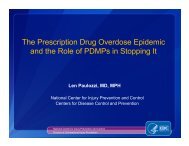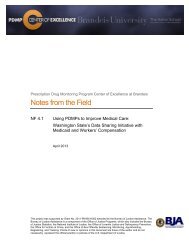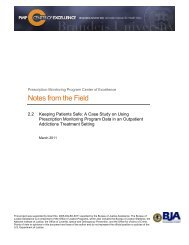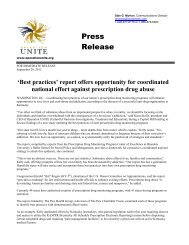Nevada's Proactive PMP - PDMP Center of Excellence
Nevada's Proactive PMP - PDMP Center of Excellence
Nevada's Proactive PMP - PDMP Center of Excellence
Create successful ePaper yourself
Turn your PDF publications into a flip-book with our unique Google optimized e-Paper software.
Prescription Monitoring Program <strong>Center</strong> <strong>of</strong> <strong>Excellence</strong> at Brandeis<br />
Notes from the Field<br />
NF 2.5<br />
Nevada’s <strong>Proactive</strong> <strong>PMP</strong>: The Impact <strong>of</strong> Unsolicited<br />
Reports<br />
October, 2011<br />
This project was supported by Grant No. 2009-PM-BX-K044 awarded by the Bureau <strong>of</strong> Justice Assistance. The<br />
Bureau <strong>of</strong> Justice Assistance is a component <strong>of</strong> the Office <strong>of</strong> Justice Programs, which also includes the Bureau<br />
<strong>of</strong> Justice Statistics, the National Institute <strong>of</strong> Justice, the Office <strong>of</strong> Juvenile Justice and Delinquency Prevention,<br />
and the Office for Victims <strong>of</strong> Crime. Points <strong>of</strong> view or opinions in this document are those <strong>of</strong> the author and do<br />
not represent the <strong>of</strong>ficial position or policies <strong>of</strong> the U.S. Department <strong>of</strong> Justice.
Notes from the Field<br />
Nevada’s <strong>Proactive</strong> <strong>PMP</strong>: The Impact <strong>of</strong> Unsolicited Reports<br />
Overview<br />
The Nevada Prescription Monitoring Program (<strong>PMP</strong>) was conceived as an alternative to<br />
law enforcement in addressing prescription drug diversion and abuse. From its inception<br />
in 1997, administrators sent prescribers and pharmacists unsolicited prescription history<br />
reports on individuals who were probable doctor shoppers, an innovation for <strong>PMP</strong>s. Data<br />
from Nevada indicate that in the months following reports, these individuals reduced<br />
their purchases <strong>of</strong> controlled substances. Moreover, for individuals reported on, the<br />
average number <strong>of</strong> dosage units received, as well as doctors and pharmacies visited,<br />
decreased in subsequent years. Unsolicited reports also generated interest in the <strong>PMP</strong><br />
among medical providers and other stakeholders, such that they began requesting<br />
reports on their own initiative (solicited reports). The number <strong>of</strong> solicited reports<br />
distributed by the <strong>PMP</strong> rapidly increased during the first years <strong>of</strong> the program. The<br />
Nevada <strong>PMP</strong>, now a largely automated, cost-efficient system, continues to play an<br />
important role in reducing the diversion <strong>of</strong> controlled substances in Nevada.<br />
Inception: pro-active reporting from the outset<br />
In the early 1990’s, Nevada faced a serious public health threat from prescription drug<br />
abuse, fueled by rapid population growth and an increase in the prescribing <strong>of</strong> pain<br />
medications. The developers <strong>of</strong> the Nevada <strong>PMP</strong>, Keith Macdonald, R.Ph, then<br />
Executive Director <strong>of</strong> the Nevada State Board <strong>of</strong> Pharmacy, and Joanee Quirk, the <strong>PMP</strong><br />
Program Administrator, conceived it as a practitioner-focused, medically-oriented<br />
alternative to law enforcement in reducing the diversion <strong>of</strong> controlled substances and the<br />
associated addiction, overdoses and deaths. As they described the pre-<strong>PMP</strong> situation,<br />
drug diversion investigators would <strong>of</strong>ten spend days visiting pharmacies and prescribers,<br />
compiling evidence in support <strong>of</strong> relatively few cases. A practitioner-focused <strong>PMP</strong>, they<br />
reasoned, could pro-actively transmit data on suspicious purchases <strong>of</strong> controlled<br />
substances to prescribers and pharmacists, as well as to drug investigators. 1 Many <strong>of</strong><br />
these practitioners were likely unaware that some <strong>of</strong> their patients were probable doctor<br />
shoppers. Rather than treat all instances <strong>of</strong> suspected doctor shopping as targets for<br />
criminal investigation, medical providers could identify and help patients who might be<br />
abusing or addicted to prescription drugs. Clinical interventions might include changing<br />
the amount or type <strong>of</strong> drugs prescribed, requiring that a patient see only one prescriber,<br />
conducting a substance abuse brief intervention, or referring the patient to a treatment<br />
specialist for pain or substance abuse. Compared to diversion investigations alone, the<br />
practitioner approach would allow many more individuals to get help for behavioral and<br />
1 Drug investigator use <strong>of</strong> <strong>PMP</strong> data is described in the COE Notes from the Field publication “Perspective<br />
from Kentucky: Using <strong>PMP</strong> Data in Drug Diversion Investigations,” available at<br />
http://www.pmpexcellence.org/sites/all/pdfs/NFF_kentucky_5_17_11_c.pdf.<br />
2 <strong>PMP</strong> <strong>Center</strong> <strong>of</strong> <strong>Excellence</strong> at Brandeis University www.pmpexcellence.org
Nevada’s <strong>Proactive</strong> <strong>PMP</strong><br />
medical problems, for less cost, and without incurring drug diversion charges and a<br />
possible criminal record.<br />
Legislation enabling the <strong>PMP</strong> was introduced in 1995 and passed with support from a<br />
broad-based constituency that formed the Prescription Controlled Substance Abuse<br />
Prevention Task Force. Members included Nevada law enforcement agencies,<br />
prescribers, pharmacists, and medical and dental boards. Law enforcement, which was<br />
primarily focused on investigations involving street drugs (heroin, cocaine, marijuana),<br />
agreed that the <strong>PMP</strong>-medical approach was appropriate for most low-level controlled<br />
substance diversion cases, so no turf issues arose. The Nevada Board <strong>of</strong> Pharmacy<br />
took responsibility for organizing and housing the <strong>PMP</strong> with solid support from local and<br />
chain pharmacies, who understood the seriousness <strong>of</strong> the prescription drug abuse<br />
problem. The pharmacies also had access to the information technology infrastructure to<br />
enable the reporting <strong>of</strong> prescription data. The <strong>PMP</strong> began operations in 1997 and was<br />
financially supported in its first two years by gifts from the state medical board and<br />
pharmaceutical companies totaling approximately $250,000. 2 Since then, the Nevada<br />
<strong>PMP</strong> has received Federal grants as well as funds from a small fee charged to doctors<br />
for the Nevada state license to prescribe controlled substances.<br />
Quirk and Macdonald recalled being apprehensive about how doctors, pharmacists and<br />
the wider community would react to unsolicited reporting <strong>of</strong> <strong>PMP</strong> data, since it had never<br />
been tried before by any <strong>PMP</strong>. Would concerns about confidentiality, misuse <strong>of</strong><br />
prescription information, and heavy-handed surveillance <strong>of</strong> prescribing spark resistance<br />
Would practitioners bother to read patient prescription histories and use them in their<br />
clinical decision-making How well would unsolicited reports work as a strategy to jumpstart<br />
the Nevada <strong>PMP</strong> The first reports were faxed to providers in April <strong>of</strong> 1997.<br />
Impact <strong>of</strong> unsolicited reports<br />
Overall, the response was largely positive and the results encouraging. Except for a few<br />
critical newspaper editorials, no significant opposition to the <strong>PMP</strong> or its unsolicited<br />
reporting materialized. This was most likely because the Task Force had sought input<br />
from all affected constituencies and had conducted advance education regarding the<br />
<strong>PMP</strong> and its objectives. According to Quirk and Macdonald, the unsolicited reports took<br />
providers by surprise, but quickly generated interest in the <strong>PMP</strong> since many prescribers<br />
were unaware that some <strong>of</strong> their patients were possible doctor shoppers. This resulted in<br />
a rapid increase in practitioner-initiated requests for more <strong>PMP</strong> data, that is, solicited<br />
reports (see Figure 1, page 7).<br />
Data from the first years <strong>of</strong> the Nevada <strong>PMP</strong> suggest that unsolicited reporting, perhaps<br />
in combination with solicited reports, helped to reduce doctor shopping. Nevada’s<br />
2 As reported to the National Conference <strong>of</strong> State Legislatures, Nevada received $265,000 for the first two<br />
years <strong>of</strong> its program’s operations, including two-year grants from two pharmaceutical companies and the<br />
state Board <strong>of</strong> Medical Examiners, see http://www.ncsl.org/default.aspxtabid=14428.<br />
3 <strong>PMP</strong> <strong>Center</strong> <strong>of</strong> <strong>Excellence</strong> at Brandeis University www.pmpexcellence.org
Nevada’s <strong>Proactive</strong> <strong>PMP</strong><br />
approach to generating unsolicited reports, innovative for its time, became the model<br />
adopted by most states that do such reporting. Individuals were identified in the Nevada<br />
<strong>PMP</strong> database using criteria for suspected doctor shopping: meeting or exceeding a<br />
threshold for numbers <strong>of</strong> prescribers and pharmacies visited within a given time period.<br />
In 1997, the first year <strong>of</strong> operation, 4,179 individuals met this threshold, increasing to<br />
8,253 in 2002, a rise consistent with the increase in controlled substance prescriptions in<br />
Nevada over the same time period. 3 Those individuals with the greatest number <strong>of</strong><br />
prescribers and pharmacies were selected for unsolicited reporting each year, starting<br />
with 186 in 1997 and rising to 652 in 2002 (see Figure 1). More individuals were reported<br />
on in each successive year as data analysis and reporting procedures became more<br />
efficient and as more resources were made available to the <strong>PMP</strong>. The threshold<br />
individuals had to meet or exceed in order to qualify for unsolicited reporting stayed the<br />
same during these years.<br />
Individuals reported on exhibited decreases in their prescription purchases as measured<br />
by dosage units in the months after reports were issued (Figure 2, page 7) and in each<br />
year (Figure 3, page 8). In successive years the average number <strong>of</strong> prescribers and<br />
pharmacies visited (Figure 4, page 8) and average number <strong>of</strong> dosage units (Figure 3)<br />
declined for individuals for whom unsolicited reports were sent in that year (the blue line<br />
in Figure 1 shows the number reported on each year). 4 This suggests that sending <strong>PMP</strong><br />
data to medical providers had both a specific and general effect: specific in that<br />
controlled substances obtained by individuals reported on in a given year were reduced<br />
after unsolicited reports were issued, and general in that the overall level <strong>of</strong> doctor<br />
shopping declined for individuals who most exceeded the threshold in successive years.<br />
How <strong>PMP</strong> data provided to practitioners reduces doctor shopping 5<br />
A plausible explanation for these effects is that as medical providers in Nevada learned<br />
<strong>of</strong> the <strong>PMP</strong> and about their patients’ prescription histories, via both unsolicited and<br />
solicited reports (increasingly the latter as word spread about the <strong>PMP</strong>), they took this<br />
information into account in their subsequent prescribing for some patients. Once a<br />
provider discovers that a patient is obtaining multiple simultaneous prescriptions,<br />
especially for the same controlled substance, she will likely take steps to ensure that the<br />
patient is receiving only those prescriptions that are medically necessary. As more<br />
3 The increase in those reaching the threshold, up 97.5%, is comparable to the increase in controlled<br />
substance prescriptions dispensed in Nevada from 1997 to 2002, from 1,761,796 to 3,236,112, up 83.7%.<br />
4 Persons reported on in each successive year may have included some <strong>of</strong> the same individuals, but they<br />
were independently selected in each year by being those who most exceeded the doctor shopping<br />
threshold.<br />
5 This section is adapted from the <strong>Center</strong> <strong>of</strong> <strong>Excellence</strong> Notes from the Field report “Trends in Wyoming<br />
<strong>PMP</strong> Prescription History Reporting: Evidence for a Decrease in Doctor Shopping,” available at<br />
http://www.pmpexcellence.org/sites/all/pdfs/NFF_wyoming_rev_11_16_10.pdf.<br />
4 <strong>PMP</strong> <strong>Center</strong> <strong>of</strong> <strong>Excellence</strong> at Brandeis University www.pmpexcellence.org
Nevada’s <strong>Proactive</strong> <strong>PMP</strong><br />
providers in Nevada learned about their patients’ prescription histories and took<br />
appropriate action, it became more difficult for doctor shoppers to obtain medically<br />
unnecessary prescriptions from these providers. This is reflected in <strong>PMP</strong> data by the<br />
post-report decrease in dosage units obtained by individuals reported on, as well as the<br />
successive yearly decline in the number <strong>of</strong> prescribers and pharmacies visited by<br />
individuals who most exceeded the threshold for probable doctor shopping.<br />
Limitations<br />
Certain limitations apply to the data and conclusions <strong>of</strong> this report. As shown in figure 3,<br />
when comparing the 12 month periods pre and post the sending <strong>of</strong> unsolicited reports,<br />
the average number <strong>of</strong> doses for individuals reported on shows a sharp drop. In figure 2,<br />
a similar decline is shown in the months after reports were issued. It’s therefore<br />
reasonable to conclude that <strong>PMP</strong> reporting likely played a role in reducing prescriptions<br />
obtained by suspected doctor shoppers. However, how much <strong>of</strong> this reduction is<br />
attributable to unsolicited reports alone is unclear since other factors may have played a<br />
role, including solicited reports sent to providers and other influences on an individual’s<br />
behavior, such as law enforcement and trends unrelated to drug control. This<br />
uncertainty, plus the possibility <strong>of</strong> regression to the mean, highlights the importance <strong>of</strong><br />
including a comparable non-intervention group <strong>of</strong> possible doctor shoppers (for whom no<br />
reports are sent) in a rigorous assessment <strong>of</strong> the impact <strong>of</strong> unsolicited reporting. 6<br />
Another limitation <strong>of</strong> this report concerns the fate <strong>of</strong> individuals showing declines in drug<br />
purchases and prescribers and pharmacies visited as measured in <strong>PMP</strong> data. Although<br />
such declines are consistent with reduced prescription drug use and better clinical<br />
practice, the possibility that some individuals found other sources <strong>of</strong> drugs that escaped<br />
detection by the <strong>PMP</strong> can’t be ruled out. Doctor shoppers may travel to other states to<br />
find prescriptions, buy drugs from street dealers, or resort to theft. Those addicted to<br />
prescription opiates may turn to heroin as a sometimes readily available and cheaper<br />
alternative. Such outcomes can be mitigated by providing good diagnostic and clinical<br />
care to patients with substance abuse or chronic pain syndromes. Studies <strong>of</strong> the<br />
diagnosis, treatment, referral and discharge history <strong>of</strong> patients identified as possible<br />
doctor shoppers, along with information on diversion activities and arrests, would help fill<br />
in the story behind changes in their <strong>PMP</strong> data.<br />
Conclusion<br />
Despite these limitations, data from the early years <strong>of</strong> Nevada’s <strong>PMP</strong> suggest that the<br />
decision to issue unsolicited reports paid <strong>of</strong>f, both as a strategy to generate awareness<br />
and interest in the <strong>PMP</strong>, and as a tool to improve clinical practice and change patient<br />
6 The <strong>Center</strong>s for Disease Control has recently initiated studies <strong>of</strong> the impact <strong>of</strong> unsolicited reporting using<br />
randomly selected intervention and non-intervention groups.<br />
5 <strong>PMP</strong> <strong>Center</strong> <strong>of</strong> <strong>Excellence</strong> at Brandeis University www.pmpexcellence.org
Nevada’s <strong>Proactive</strong> <strong>PMP</strong><br />
behavior. Nevada’s unsolicited reporting initiative set an important precedent in the<br />
design and goals <strong>of</strong> an effective <strong>PMP</strong>, one that proactively engages the resources <strong>of</strong> the<br />
medical community in fighting prescription drug abuse. 7 Ω<br />
Note: For inquiries concerning this report, please contact the <strong>PMP</strong> <strong>Center</strong> <strong>of</strong> <strong>Excellence</strong><br />
at Brandeis at www.pmpexcellence.org or call 781-736-3909.<br />
7 Another Nevada <strong>PMP</strong> initiative is described in the <strong>Center</strong> <strong>of</strong> <strong>Excellence</strong> Notes from the Field report<br />
“Staying Clear <strong>of</strong> the Law and Addiction: Nevada’s Pre-Criminal Intervention Program,” at<br />
http://www.pmpexcellence.org/sites/all/pdfs/2_nevada_pcip_nff_1_19_11.pdf.<br />
6 <strong>PMP</strong> <strong>Center</strong> <strong>of</strong> <strong>Excellence</strong> at Brandeis University www.pmpexcellence.org
Nevada’s <strong>Proactive</strong> <strong>PMP</strong><br />
Figure 1<br />
Nevada <strong>PMP</strong>: Unsolicited and Solicited Reports<br />
Number <strong>of</strong> Reports<br />
12,000<br />
10,000<br />
8,000<br />
6,000<br />
4,000<br />
2,000<br />
0<br />
Unsolicited reports<br />
Solicited reports<br />
10,935<br />
6,896<br />
4,530<br />
3,247<br />
1,641<br />
480<br />
475 481 559 652<br />
162<br />
182<br />
1997 1998 1999 2000 2001 2002<br />
Year<br />
Figure 2<br />
Mean Dosage Units<br />
Nevada <strong>PMP</strong>: Mean Monthly Dosage Units for<br />
Individuals in Unsolicited Reports, 1997<br />
600<br />
500<br />
400<br />
300<br />
200<br />
100<br />
0<br />
April reports (15 patients)<br />
May reports (18 patients)<br />
June reports (7 patients)<br />
Month<br />
Note: Each line represents the mean monthly number <strong>of</strong> dosage units for each group <strong>of</strong><br />
individuals for whom unsolicited reports were sent. The group represented by the blue line were<br />
reported on in April (15 individuals), those by the magenta line in May (18), and those by the<br />
green line in June (7).<br />
7 <strong>PMP</strong> <strong>Center</strong> <strong>of</strong> <strong>Excellence</strong> at Brandeis University www.pmpexcellence.org
Nevada’s <strong>Proactive</strong> <strong>PMP</strong><br />
Figure 3<br />
Doseage Units<br />
450<br />
400<br />
350<br />
300<br />
250<br />
200<br />
150<br />
100<br />
50<br />
0<br />
Nevada <strong>PMP</strong>: Mean Dosage Units Pre/Post<br />
Unsolicited Reports<br />
1997 1998 1999 2000 2001 2002<br />
Year<br />
Pre report<br />
Post report<br />
Note: Pre and post report periods were each 12 months. See Figure 1 for the number <strong>of</strong><br />
individuals reported on in each year (blue line).<br />
Figure 4<br />
Nevada <strong>PMP</strong>: Mean # <strong>of</strong> Prescribers and<br />
Pharmacies for Individuals in Unsolicited Reports<br />
Mean # <strong>of</strong> Prescribers and<br />
Pharmacies<br />
25<br />
20<br />
15<br />
10<br />
5<br />
0<br />
Mean # Prescribers<br />
Mean # Pharmacies<br />
1997 1998 1999 2000 2001 2002<br />
Year<br />
Note: Means are calculated for numbers <strong>of</strong> prescribers and pharmacies visited by individuals<br />
reported on within each calendar year. See Figure 1 for the number <strong>of</strong> individuals reported on in<br />
each year (blue line).<br />
8 <strong>PMP</strong> <strong>Center</strong> <strong>of</strong> <strong>Excellence</strong> at Brandeis University www.pmpexcellence.org








